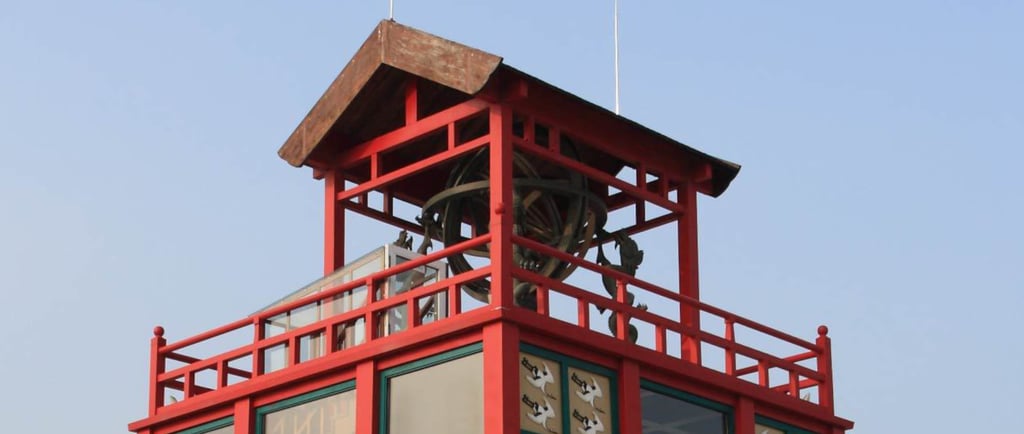Su Sung’s Astronomical Water Clock 🌊🌌Medieval Timekeeping
Stories About Time: Measuring Moments Through History ⏳🌞🌕 from the chapter "Towards an Understanding of Linear Time" from the History Album. In this chapter we invite children to a journey through the fascinating evolution of timekeeping. Starting with observing the Sun🌞, and people who first noticed the movement of shadows to mark the day, to the people who noticed the phrases of the Moon 🌙, and tracked the lunar cycle to create months, these stories uncover humanity’s inventive ways of measuring moments.Children will marvel at ancient innovations, like sundials and lunar calendars, and explore cultural contributions, such as candle clocks 🕯️ and water clocks 🌊, that paved the way for modern timekeeping. Each story weaves history, science, and culture, showing how humans connected with the natural world to organize their lives. 🌿✨Through these narratives, children will see time not just as a number on a clock, or passing month on the callendar, but as a rich legacy of human curiosity and creativity. With hands-on activities like building sundials and journaling moon phases, they’ll become modern-day timekeepers, inspired to ask, “How did people measure time before clocks?” and “What can I discover about time?”This vivid exploration links the past to the present, sparking imagination and a deeper appreciation for the ingenuity of those who came before us. 🌍✨
HISTORY STORIES
12/13/20243 min read


Do you remember how candle clocks 🕯️ helped people measure time indoors, even in the darkest hours of night? They burned steadily, marking hours with carved lines or the gentle drop of a nail into a tray. Candle clocks were simple and ingenious, but they had their limits. What if you needed a clock that could run continuously, rain or shine, day or night? 🌌What if timekeeping wasn’t just about the hours? What if a clock could tell you more—like the movements of the stars ✨ and planets 🌍?
In ancient China, over 900 years ago, a brilliant inventor named Su Sung had a daring idea: to create a clock so extraordinary it could show the movements of the planets while tracking the passing hours.Back then, people didn’t just need to know what time it was—they needed to know when to plant their crops 🌾, celebrate special days 🎉, and even watch the stars to plan important events.
The emperor wanted a clock that could do all this and more, and he wanted it to be so amazing that everyone who saw it would be amazed by his great empire! “Build me a clock that will wow the world,” the emperor said to Su Sung. And so, the inventor set to work on one of the most incredible clocks in history.
Su Sung thought and thought. “How can I build a clock that doesn’t just tell the time but also shows how the stars and planets move?” he wondered. He started drawing plans, but this clock would be nothing like the simple clocks people had seen before. This clock would be powered by water 🌊, something smooth and steady that would never stop flowing. Even when winter tried to freeze time, Su Sung and his team found clever ways to keep the clock ticking! 😊
For seven long years, Su Sung and his team worked day and night to build the clock. Finally, in 1092, it was ready! Standing tall in the capital city, Su Sung’s clock was like nothing anyone had ever seen before. It wasn’t just a clock—it was a whole tower 🏯, as tall as a building, with magical moving parts inside.
It was so tall—12 meters—that’s like stacking three grown-up giraffes 🦒 on top of each other, or putting four school buses 🚍 in a row standing upright!
🏯 It was like a giant science puzzle.
At the very top, there’s a celestial globe🌌 that spins slowly, showing the stars and planets as they move across the sky. It’s like having a map of the night sky right on the clock!👏 Ce – les – ti – al 👏 👏 Globe 👏 means a "heavenly sphere" . Like the map of the stars in the sky from the northern and southern hemisphere.
Below the globe, you’ll notice some beautifully decorated panels 📜. These panels showed the time, the date, and even the phases of the moon 🌙. And look at those little figures standing in rows on the sides! 👩🎤🥁 They weren’t just decorations—they moved to announce the hours, striking drums and gongs at just the right time. These figures are like tiny actors in a play—they would come out at specific times to strike drums and gongs 🛎️, announcing the hours to everyone in the city. It must have been so exciting to watch them move!
The whole clock worked because of the flowing water. The water turned gears ⚙️, which moved chains, which made the celestial globe and clock hands turn. Everything was connected like a big, clever puzzle.
The emperor was so proud of Su Sung’s clock. “This clock will show the world how smart and advanced our empire is!” he said. And people from faraway lands came to see this amazing invention.
There was one little problem—Su Sung wasn’t very good at keeping his notes organized. When invaders took the clock apart years later, they couldn’t figure out how to put it back together! Can you imagine looking at all the pieces and thinking, “What does this even do?”
Su Sung’s Astronomical Water Clock 🌌 was a marvel of its time, but its size and complexity meant it was reserved for the emperor’s court. In other parts of the world, people sought simpler ways to measure time that could be carried anywhere. This led to the invention of a portable and clever timekeeper. How did it work, and why did it become so popular?
That’s a story for another day… ⏳✨
This story is part of the following Clock Stories Series which can be turned into Drama Play or Storybook Compilation.
Ancient Timekeeping
🌞 The Sun Watchers ~3500 BCE
🌊 The Water Clock Wonders ~1500 BCE
🏛️ The Tower of the Winds ~50 BCE
Medieval Timekeeping
🕯️ The Candle Clock ~980 CE
🌌 Su Sung’s Astronomical Water Clock ~1092 CE
⏳ The Hourglass Sand Masters ~14th Century
🛎️ The Mechanical Church Bells Chime ~14th Century
Science in Timekeeping
🌟 Astronomical Marvel: The Prague Clock ~1410 CE
🌍 Galileo’s Pendulum Discovery ~1602 CE
🕰️ Pendulum Perfection ~1656 CE
Modern Timekeeping
🌊 Marine Chronometer ~18th Century
⏱️ The Quartz Revolution ~1920s CE
With Montessori joy,
Vanina 😊

